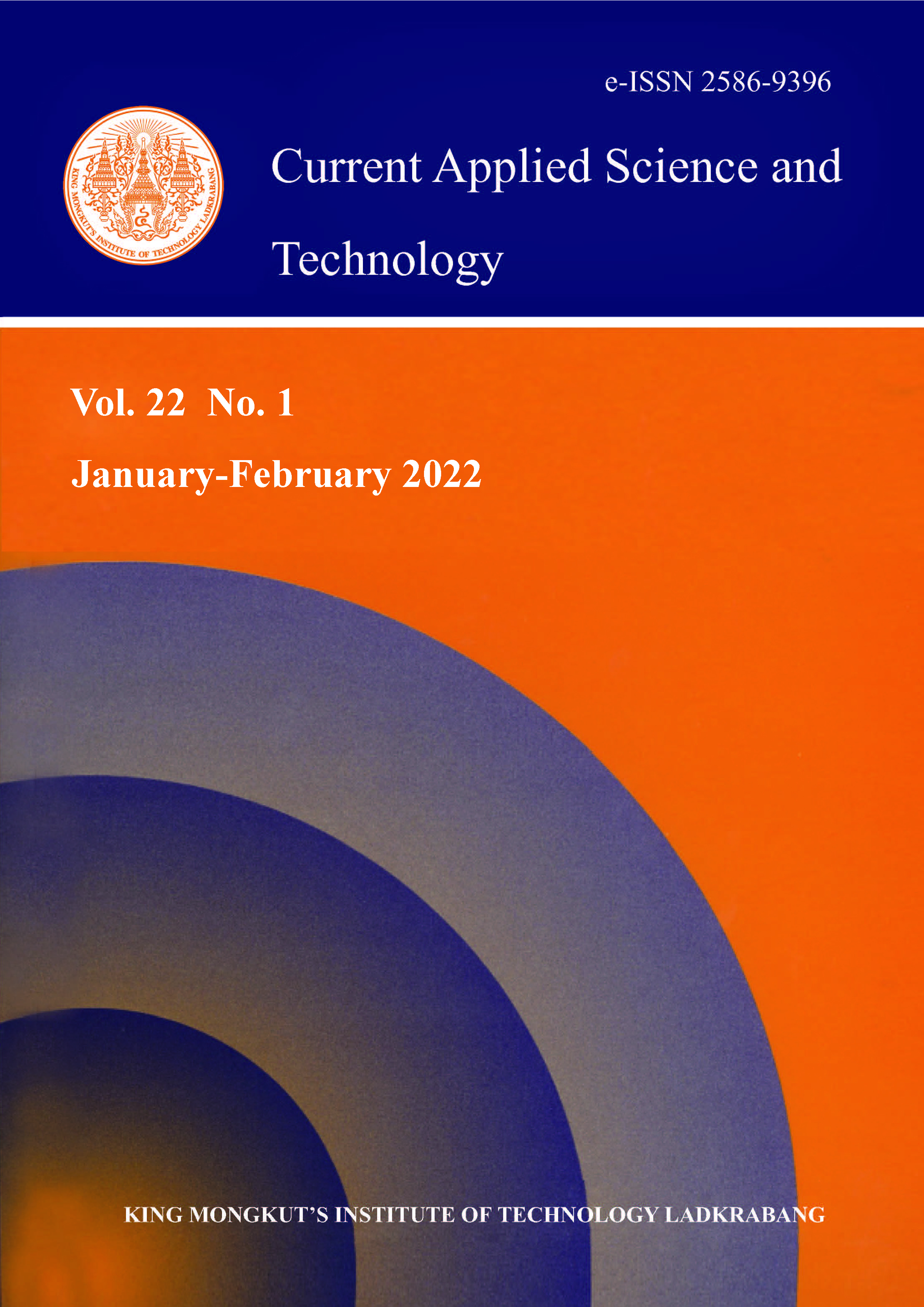Acoustic Sensing for Quality Edible Evaluation of Sriracha Pineapple Using Convolutional Neural Network
Main Article Content
Abstract
Sriracha pineapple is a pineapple of the Smooth Cayenne variety and is one of Thailand's favorite tropical fruits. It is not only one of the most favorite agricultural products for the pineapple processing and canning industries but it is also widely consumed as a fresh fruit. Many exporters and consumers prefer to measure juiciness before processing food products and consuming, respectively. The traditional method used by pineapple sellers or farmers for fruit juiciness classification is to tap the pineapple using force impulse techniques with a rubber-tipped stick or a person's middle finger tapping. However, these traditional methods of classification require a lot of expertise and experience. Thus, the inspector's perception of accomplishing the classification process may be inclined to errors and uneven results. This paper proposes a combination of acoustic sensing and convolutional neural network (CNN). The tapping sound of 30 Sriracha pineapple samples using force impulse techniques was recorded on smartphone. The tapping sounds were processed into a juiciness classification system of three classes: (1) Juiciness 1, (2) Juiciness 2, and (3) Juiciness 3. The system involved a combination of acoustic sensing and CNN to compare the results between Mel Frequency Cepstral Coefficient (MFCC) and Mel-Spectrogram features extraction, with replication of the same CNN model, to evaluate the pineapple's edibility from its juiciness level. Experimental results showed that MFCC combined with CNN performed the best, with an accuracy of 96.67% and F1-score of 0.97. It outperformed the Mel-spectrogram combined with CNN.
Keywords: acoustic sensing; quality edible evaluation; deep learning; pineapple juiciness; classification; MFCC; Mel-Spectrogram
*Corresponding author: Tel.: (+66) 861777572
E-mail: pongpinigpinyo_s@su.ac.th
Article Details
Copyright Transfer Statement
The copyright of this article is transferred to Current Applied Science and Technology journal with effect if and when the article is accepted for publication. The copyright transfer covers the exclusive right to reproduce and distribute the article, including reprints, translations, photographic reproductions, electronic form (offline, online) or any other reproductions of similar nature.
The author warrants that this contribution is original and that he/she has full power to make this grant. The author signs for and accepts responsibility for releasing this material on behalf of any and all co-authors.
Here is the link for download: Copyright transfer form.pdf
References
Dittakan, K., Theera-Ampornpunt, N. and Boodliam, P., 2018. Non-destructive grading of Pattavia pineapple using texture analysis. The 21stInternational Symposium on Wireless Personal Multimedia Communications. Chiang Rai, Thailand, November 25-28, 2018, pp. 144-149.
Sornsrivichai, J., Yantarasri, T. and Kalayanamitra, K., 2000. Nondestructive techniques for quality evaluation of pineapple fruits. Acta Horticulturae (International Pineapple Symposium), 529, 337-341.
Bueno, G.E., Valenzuela, K.A. and Arboleda, E.R., 2020. Maturity classification of cacao through spectrogram and convolutional neural network. Jurnal Teknologi dan Sistem Komputer, 8(3), 228-233.
Chaikaew, A., Thanavanich, T., Duangtang, P., Sriwanna, K. and Jaikhang, W., 2019. Convolutional neural network for pineapple ripeness classification machine. Proceeding of the 16th International Conference on Electrical Engineering/Electronics, Computer, Telecommunications and Information Technology, Pattaya, Thailand, July 10-13, 2019, pp. 373-376.
Kharamat, W., Wongsaisuwan, M. and Wattanamongkhol, N. 2020., Durian ripeness classification from the knocking sounds using convolutional neural network. The 8th International Electrical Engineering Congress. Chiang Mai, Thailand, March 4-6, 2020, pp. 1-4.
Azman, A.A. and Ismail, F.S., 2017. Convolutional neural network for optimal pineapple harvesting. Journal of Electrical Engineering, 16(2), https://doi.org/10.11113/elektrika.v16n2.54
Lashgari, M., Imanmehr, A., and Tavakoli, H., 2020. Fusion of acoustic sensing and deep learning techniques for apple mealiness detection. Journal of Food Science and Technology, 57(6), 2233-2240.
Caladcad, J.A.A., Cabahug, S., Catamco, M.R., Villaceran, P.E., Cosgafa, L., Cabizares, K.N., Hermosilla, M. and Piedad, E., 2020. Determining Philippine coconut maturity level using machine learning algorithms based on acoustic signal. Computer and Electronics in Agriculture, 172, 105327, https://doi.org/10.1016/j.compag.2020.105327.
Rahmawati, D., Haryanto, H. and Sakariya, F., 2019. The design of coconut maturity prediction device with acoustic frequency detection using Naïve Bayes method based microcontroller. Journal of Electrical Engineering, Mechatronic and Computer Science, 2(1), https://doi.org/10.26905/jeemecs.v2i1.2806.
Baki, S.R.M.S., Z., M.A.M., Yassin, I.M., Hasliza, A.H. and Zabidi, A., 2010. Non-destructive classification of watermelon ripeness using Mel-Frequency Cepstrum Coefficients and Multilayer Perceptrons. The 2010 International Joint Conference on Neural Networks. Barcelona, Spain, July 18-23, 2010, pp. 1-6.
Bui, K.N., Oh, H. and Yi, H., 2020. Traffic density classification using sound datasets: An empirical study on traffic flow at asymmetric roads. IEEE Access, 8, 125671-125679.






